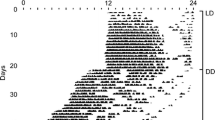Abstract
The present study describes the role of light in entraining the locomotor activity pattern of the blind mole rate, Spalax ehrenbergi, a rodent well adapted to a totally subterranean life. Mole rats were found to have a diurnal monophasic activity pattern under laboratory conditions with 14L/1OD photoperiod. The light stimulus received by their atrophied eyes is the main zeitgeber in entraining their activity rhythm. Under constant dim light the animals free run with period lengths of close to 24 h.
Access this chapter
Tax calculation will be finalised at checkout
Purchases are for personal use only
Preview
Unable to display preview. Download preview PDF.
Similar content being viewed by others
References
Aschoff, J. (1981). Free running and entrained circadian rhythms. Handbook of Behavioral Neurobiology. Vol. 4. Biological Rhythms, edited by J. Aschoff (Plenum, New-York) pp. 81–94.
Ashby, K.R. (1972). Patterns of daily activity in mammals. Mammals review, 1, 171–185.
Bronchti, G., Rado, R., Terkel, J., and Wollberg, Z. (1989). Ontogenetic degeneration of retinal projections in the blind mole rat (Spalax ohrenbergi). Second International Congress of Neuroethology, Berlin.
Gev., H. (1084). The role of light is entraining the circadian rhythm of the mole rat. M.Sc. Thesis. Department of Zoology, Tel-Aviv University, Israel.
Haim, A., Heth, G., Pratt, H., and Nevo, E. (1983). Photoperiodic effects on thermoregulation in a “blind” subterranean mammal. Journal of Experimental Biology, 107, 59–64.
Hamar, M.J.., Suteu, C.H., and Sutara, M. (1964). Home range and activity study of the molerat(Spalax leucodon Nord.) by 60C marking. Revue Roumaine de Biologie, de Zoologie.,9,6, 421–433.
MacDonald, D. (1985). The Encyclopedia of Mammals. Vol. 2 (George Allen & Unwin, London, Sydney).
Menaker, M., and Binkley, S. (1981). Neural and endocrine control of circadian rhythms in the vertebrates. Handbook of Behavioral Neurobiology. Vol. 4. Biological Rhythms, edited by J. Aschoff (Plenum, New York), pp. 243–256.
Nevo, K. (1961). Observation on Israeli population of the mole rat Spalax ohrenbergi, Nehring 1898. Mammalia, 25, 127–144.
Nevo, K. (1979). Adaptive convergence and divergence of subterranean mammals. Annual Reviews in Ecology, 10, 269–308.
Nevo, K. (1982). Speciation in subterranean mammals. Mechanisms of Speciation, edited by Barigozzi, C. (Alan R. Liss Publication., New York), pp. 191–218.
Nevo, K., Guttman, R., Haber, M., and Erez, K. (1982). Activity patterns in evolving mole rats. Journal of Mammalogy, 63, 453–463.
Rado, R. (1987). Circadian and circannual rhythms of the mole rat. M.Sc. Thesis, Department of Zoology, Tel-Aviv, University, Israel.
Rado, R., Gev, H., and Terkel, J. (1988). The role of light in entraining mole rats’ circadian rhythm. Israel Journal of Zoology, 35, 105–106.
Rado, R., and Terkel, J. (1989). Circadian activity of the mole rat, Spalax ehrenbergi, monitored by radio telemetry, in seminatural and natural conditions. The Fourth International Conference on Environmental Quality and Kcosystem Stability, Jerusalem, Israel.
Rusak, B., and Zucker, I. (1975). Biological rhythms and animal behavior. Annual Review of Psychology, 26, 137–171.
Savix, V.I., and Mikes, M. (1967). Zur kenntnis des 24-stunden - rhythmus von Spa lax leucodon Nordmann, 1840. Zumal Saugetierkunde, 32, 233–238.
Takahashi, J.S., and Zatz, M. (1982). Regulation of circadian rhythmicity. Science, 217, 1104–1111.
Zweig, M., Snyder, S.H., and Axelrod, J. (1966). Evidence for a non-retinal pathway of light to the pineal gland of new born rats. Proceeding of the National Academy of Sciences USA, 56, 515–520.
Author information
Authors and Affiliations
Editor information
Editors and Affiliations
Rights and permissions
Copyright information
© 1991 Springer Science+Business Media New York
About this chapter
Cite this chapter
Rado, R., Gev, H., Goldman, B.D., Terkel, J. (1991). Light and Circadian Activity in the Blind Mole Rat. In: Riklis, E. (eds) Photobiology. Springer, Boston, MA. https://doi.org/10.1007/978-1-4615-3732-8_61
Download citation
DOI: https://doi.org/10.1007/978-1-4615-3732-8_61
Publisher Name: Springer, Boston, MA
Print ISBN: 978-1-4613-6661-4
Online ISBN: 978-1-4615-3732-8
eBook Packages: Springer Book Archive




